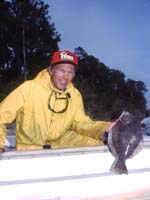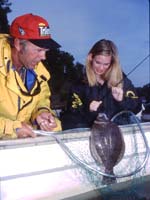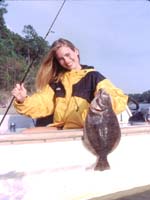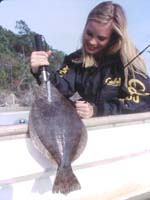
|
Features
|
|
|
|
Books
|
|
|
|
Fun & Games
|
|
|
|
Contact Us
|
|
|
John's Journal... Entry 81, Day 2
Flounder Fishing
 EDITOR'S
NOTE: Gary Davis, a charter-boat captain from Foley, Alabama, has
fished the back bays of the Gulf Shores/Orange Beach area along Alabama's
Gulf Coast all his life. He's guided for 30 years and consistently catches
more inshore species than most other anglers do because he knows the secrets
of successful back-bay fishing. Each day this week we'll look at the tactics
Davis uses to catch different species of fish throughout the year in back-bay
areas.
EDITOR'S
NOTE: Gary Davis, a charter-boat captain from Foley, Alabama, has
fished the back bays of the Gulf Shores/Orange Beach area along Alabama's
Gulf Coast all his life. He's guided for 30 years and consistently catches
more inshore species than most other anglers do because he knows the secrets
of successful back-bay fishing. Each day this week we'll look at the tactics
Davis uses to catch different species of fish throughout the year in back-bay
areas.
Question: Gary, how do you catch flounder?
Answer: The real secret to catching flounder is to know the location
of the fish and their positions on structure. Flounder generally will
hold on either wood or metal structure around inshore reefs, wrecks or
gas and oil platforms. The flounder usually bite better on an outgoing
tide because it pulls baitfish and shrimp out of the back bays and out
toward the open Gulf of Mexico. They will bite on an incoming tide, but
the worst time to fish for flounder is when there's little or no tide.
 Question:
Where's your favorite place to fish for flounder in your region?
Question:
Where's your favorite place to fish for flounder in your region?
Answer: I fish the sections of Mobile Bay that have oil and gas
rigs. Most anglers who fish for flounder will fish around the parts of
rig's legs that they can see. Many of them don't realize that the legs
of those rigs don't go straight down to the bottom but instead go away
from the rig at an angle. The bottom of the legs of the rig may be 20
or 30 yards away from the rig. I like to fish around the bottoms of these
rig legs where few other anglers fish.
Question: What baits do you use for flounder?
Answer: I fish with Berkley Inshore Power Grubs with a jighead,
Berkley Inshore Power Tubes with a jighead or live shrimp with a piece
of shot lead 6 to 8 inches up the line. I'll fish with Berkley's Big Game
Line -- usually 17-pound test -- because of its abrasion resistance. If
I'm fishing in the summertime when the water's extremely clear, then I
may use Trilene XT 10- to 12-pound-test line. I just hop the bait along
the bottom and wait for the bite.
 Question:
What does a flounder's bite feel like?
Question:
What does a flounder's bite feel like?
Answer: Many times the flounder will feel like you've picked up
a dishrag. The fish won't jerk on the line because it's already inhaled
the bait. You need to set the hook when you feel any pressure on the line.
Question: What if you miss the flounder when you
strike?
 Answer:
I generally let my grub or tube fall back to the bottom and begin to twitch
it slightly. Then it's moving but not jumping along the bottom. Many times,
the flounder will come back and take the bait a second or a third time.
When a fish short-strikes like this, it will grab the tail of the jig
or the tube. Many times when I feel a flounder take the bait, I'll delay
setting the hook for two or three seconds to make sure it's got the tube
well in its mouth. Because the Berkley Power Baits have an active ingredient
that tastes good to the flounder, they will hold this bait in their mouths
longer than they will any other type of jig. Then I have more time to
set the hook on the flounder. When you fish bull minnows or live shrimp
and the flounder hits this bait, the flounder usually will kill it and/or
eat part of it, which forces you to re-bait. However, if a flounder hits
an Inshore Power Tube or Grub, you can leave the bait on the bottom by
the flounder and continue to fish for it. These artificial lures allow
you to keep a bait that the flounder will eat in the fish's strike zone
longer than you can a live bait. Contact Gary Davis at 218 West Marigold
Avenue, Foley, Al 36535, (334) 943-6298.
Answer:
I generally let my grub or tube fall back to the bottom and begin to twitch
it slightly. Then it's moving but not jumping along the bottom. Many times,
the flounder will come back and take the bait a second or a third time.
When a fish short-strikes like this, it will grab the tail of the jig
or the tube. Many times when I feel a flounder take the bait, I'll delay
setting the hook for two or three seconds to make sure it's got the tube
well in its mouth. Because the Berkley Power Baits have an active ingredient
that tastes good to the flounder, they will hold this bait in their mouths
longer than they will any other type of jig. Then I have more time to
set the hook on the flounder. When you fish bull minnows or live shrimp
and the flounder hits this bait, the flounder usually will kill it and/or
eat part of it, which forces you to re-bait. However, if a flounder hits
an Inshore Power Tube or Grub, you can leave the bait on the bottom by
the flounder and continue to fish for it. These artificial lures allow
you to keep a bait that the flounder will eat in the fish's strike zone
longer than you can a live bait. Contact Gary Davis at 218 West Marigold
Avenue, Foley, Al 36535, (334) 943-6298.
TOMORROW: Sheepshead
Check back each day this week for more about Gary Davis -- Inshore Fishing Guide ...
Day 1 -Davis on Speckled
Trout
Day 2 -Flounder Fishing
Day 3 -Sheepshead
Day 4 -Redfish
Day 5 -More Speckled Trout